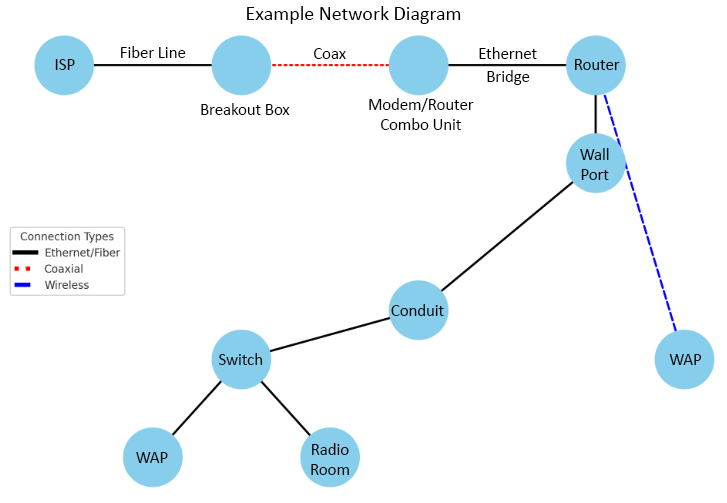Advanced Home Network Design and Implementation
In 2019, I spearheaded the comprehensive design and implementation of an advanced home network. This initiative was launched to establish robust connectivity across multiple buildings on a large property, optimizing for high performance and reliability. The project involved strategic hardware selection, advanced router configurations, and customized Ethernet installations.
The project was necessitated by a lightning strike that severely damaged the existing networking equipment at my grandparents’ residence. In response, I coordinated with the ISP to replace the bricked Router/Modem combo unit. Recognizing known issues with ISP equipment (both their experience and mine with the same ISP and unit) and their desire for an upgraded network, I introduced a high-end independent router (the NetGear Nighthawk RAX54S), configuring it in bridge mode to enhance network performance.
The independent router was set to manage all routing tasks, largely improving the network’s speed, range, and reliability. After configuring the router (including bridge mode, login credentials, SSID, and firewall settings), I tested the network to confirm flawless operation. Following this, I planned the network layout, which included the selection of equipment types, physical layout, Ethernet routing, and Wireless Access Point (WAP) placement.
The network architecture spanned three buildings: the central building housing the main router, a secondary building used as a workshop and radio equipment room, and a third smaller structure. The central and secondary buildings required Ethernet connectivity, facilitated by an existing underground conduit that allowed for easy cable routing.
For Ethernet cabling, I opted for CAT 8 due to its compatibility with future high-speed fiber-optic internet upgrades and its shielded twisted pair (STP) design to mitigate radio frequency interference from high-power radio equipment. The installation included two long-range WAPs: one wired directly in the workshop and another serving as a wireless repeater to cover remote areas of the property. A network switch was installed in the workshop to connect multiple devices via a single conduit-run Ethernet cable.
The installation process involved creating a new wall port behind the router for routing three Ethernet cables: two to the adjacent room and one to the workshop via the conduit. The network switch in the workshop distributed connections to various endpoints, including the radio room and the WAP, ensuring comprehensive wired and wireless coverage.
Post-installation, I conducted extensive quality, range, and security tests. A mobile device tested connectivity across all network points, achieving exemplary performance with latency below 20ms and consistent speeds, even at distances of 600 feet from any access point. Desktop-based network monitoring tools like Wireshark, Nmap, and OpenVAS were employed to scan for vulnerabilities, leading to further refinements in network configuration.
This project showcases the importance of a thoughtful network design and the selection of appropriate technology to meet specific needs. It highlights my ability to navigate complex network architectures and apply practical networking skills effectively, ensuring robust, high-speed, and secure connectivity across an extensive property.
Example Diagram of Network Layout

